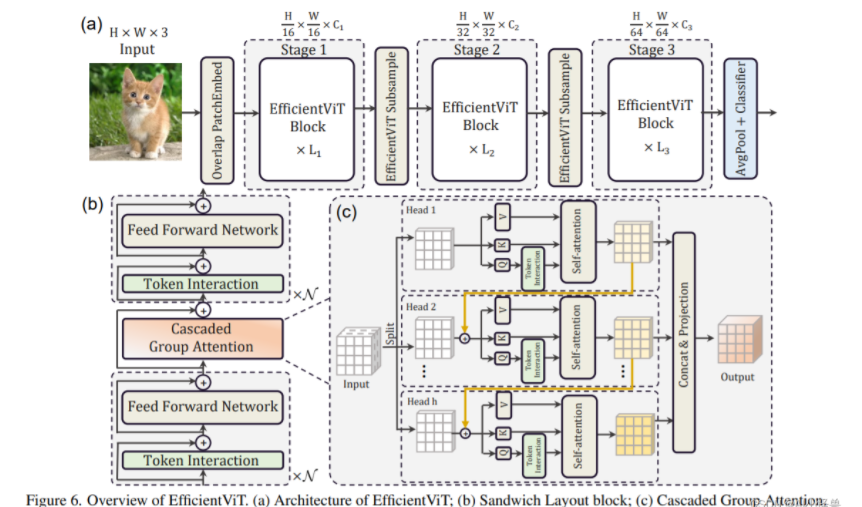RT-DETR优化改进: EfficientViT,基于级联分组注意力模块的全新实时网络架构
原创RT-DETR优化改进: EfficientViT,基于级联分组注意力模块的全新实时网络架构
原创
本文独家改进:EfficientViT助力RT-DETR ,替换backbone,包括多头自注意力(MHSA)导致的大量访存时间,注意力头之间的计算冗余,以及低效的模型参数分配,进而提出了一个高效ViT模型EfficientViT
推荐指数:五星
1.EfficientViT

论文:https://arxiv.org/abs/2305.07027
代码:Cream/EfficientViT at main · microsoft/Cream · GitHub
近些年对视觉Transformer模型(ViT)的深入研究,ViT的表达能力不断提升,并已经在大部分视觉基础任务 (分类,检测,分割等) 上实现了大幅度的性能突破。
然而,很多实际应用场景对模型实时推理的能力要求较高,但大部分轻量化ViT仍无法在多个部署场景 (GPU,CPU,ONNX,移动端等)达到与轻量级CNN(如MobileNet) 相媲美的速度。为了实现对ViT模型的实时部署,来自微软和港中文的研究者从三个维度分析了ViT的速度瓶颈,包括多头自注意力(MHSA)导致的大量访存时间,注意力头之间的计算冗余,以及低效的模型参数分配,进而提出了一个高效ViT模型EfficientViT。它以EfficientViT block作为基础模块,每个block由三明治结构 (Sandwich Layout) 和级联组注意力(Cascaded Group Attention, CGA)组成。
在ImageNet数据集上实现了 77.1% 的 Top-1 分类准确率,超越了MobileNetV3-Large 1.9%精度的同时,在NVIDIA V100 GPU和Intel Xeon CPU上实现了40.4% 和 45.2%的吞吐量提升,并且大幅领先其他轻量级ViT的速度和精度。

EfficientViT 是一个高速视觉转换器系列。 它采用具有三明治布局的新型内存高效构建块和有效的级联组注意力操作来构建,可减轻注意力计算冗余。其核心为EfficientViT block,每个EfficientViT block的输入特征先经过N个FFN,再经过一个级联组注意力CGA,再经过N个FFN层变换得到输出特征。

2. EfficientViT引入到RT-DETR
2.1 加入ultralytics/nn/backbone/efficientViT.py
核心代码:
class EfficientViTBlock(torch.nn.Module):
""" A basic EfficientViT building block.
Args:
type (str): Type for token mixer. Default: 's' for self-attention.
ed (int): Number of input channels.
kd (int): Dimension for query and key in the token mixer.
nh (int): Number of attention heads.
ar (int): Multiplier for the query dim for value dimension.
resolution (int): Input resolution.
window_resolution (int): Local window resolution.
kernels (List[int]): The kernel size of the dw conv on query.
"""
def __init__(self, type,
ed, kd, nh=8,
ar=4,
resolution=14,
window_resolution=7,
kernels=[5, 5, 5, 5],):
super().__init__()
self.dw0 = Residual(Conv2d_BN(ed, ed, 3, 1, 1, groups=ed, bn_weight_init=0., resolution=resolution))
self.ffn0 = Residual(FFN(ed, int(ed * 2), resolution))
if type == 's':
self.mixer = Residual(LocalWindowAttention(ed, kd, nh, attn_ratio=ar, \
resolution=resolution, window_resolution=window_resolution, kernels=kernels))
self.dw1 = Residual(Conv2d_BN(ed, ed, 3, 1, 1, groups=ed, bn_weight_init=0., resolution=resolution))
self.ffn1 = Residual(FFN(ed, int(ed * 2), resolution))
def forward(self, x):
return self.ffn1(self.dw1(self.mixer(self.ffn0(self.dw0(x)))))
class EfficientViT(torch.nn.Module):
def __init__(self, img_size=400,
patch_size=16,
frozen_stages=0,
in_chans=3,
stages=['s', 's', 's'],
embed_dim=[64, 128, 192],
key_dim=[16, 16, 16],
depth=[1, 2, 3],
num_heads=[4, 4, 4],
window_size=[7, 7, 7],
kernels=[5, 5, 5, 5],
down_ops=[['subsample', 2], ['subsample', 2], ['']],
pretrained=None,
distillation=False,):
super().__init__()
resolution = img_size
self.patch_embed = torch.nn.Sequential(Conv2d_BN(in_chans, embed_dim[0] // 8, 3, 2, 1, resolution=resolution), torch.nn.ReLU(),
Conv2d_BN(embed_dim[0] // 8, embed_dim[0] // 4, 3, 2, 1, resolution=resolution // 2), torch.nn.ReLU(),
Conv2d_BN(embed_dim[0] // 4, embed_dim[0] // 2, 3, 2, 1, resolution=resolution // 4), torch.nn.ReLU(),
Conv2d_BN(embed_dim[0] // 2, embed_dim[0], 3, 1, 1, resolution=resolution // 8))
resolution = img_size // patch_size
attn_ratio = [embed_dim[i] / (key_dim[i] * num_heads[i]) for i in range(len(embed_dim))]
self.blocks1 = []
self.blocks2 = []
self.blocks3 = []
for i, (stg, ed, kd, dpth, nh, ar, wd, do) in enumerate(
zip(stages, embed_dim, key_dim, depth, num_heads, attn_ratio, window_size, down_ops)):
for d in range(dpth):
eval('self.blocks' + str(i+1)).append(EfficientViTBlock(stg, ed, kd, nh, ar, resolution, wd, kernels))
if do[0] == 'subsample':
#('Subsample' stride)
blk = eval('self.blocks' + str(i+2))
resolution_ = (resolution - 1) // do[1] + 1
blk.append(torch.nn.Sequential(Residual(Conv2d_BN(embed_dim[i], embed_dim[i], 3, 1, 1, groups=embed_dim[i], resolution=resolution)),
Residual(FFN(embed_dim[i], int(embed_dim[i] * 2), resolution)),))
blk.append(PatchMerging(*embed_dim[i:i + 2], resolution))
resolution = resolution_
blk.append(torch.nn.Sequential(Residual(Conv2d_BN(embed_dim[i + 1], embed_dim[i + 1], 3, 1, 1, groups=embed_dim[i + 1], resolution=resolution)),
Residual(FFN(embed_dim[i + 1], int(embed_dim[i + 1] * 2), resolution)),))
self.blocks1 = torch.nn.Sequential(*self.blocks1)
self.blocks2 = torch.nn.Sequential(*self.blocks2)
self.blocks3 = torch.nn.Sequential(*self.blocks3)
self.channel = [i.size(1) for i in self.forward(torch.randn(1, 3, 640, 640))]
def forward(self, x):
outs = []
x = self.patch_embed(x)
x = self.blocks1(x)
outs.append(x)
x = self.blocks2(x)
outs.append(x)
x = self.blocks3(x)
outs.append(x)
return outs
EfficientViT_m0 = {
'img_size': 224,
'patch_size': 16,
'embed_dim': [64, 128, 192],
'depth': [1, 2, 3],
'num_heads': [4, 4, 4],
'window_size': [7, 7, 7],
'kernels': [7, 5, 3, 3],
}
EfficientViT_m1 = {
'img_size': 224,
'patch_size': 16,
'embed_dim': [128, 144, 192],
'depth': [1, 2, 3],
'num_heads': [2, 3, 3],
'window_size': [7, 7, 7],
'kernels': [7, 5, 3, 3],
}
EfficientViT_m2 = {
'img_size': 224,
'patch_size': 16,
'embed_dim': [128, 192, 224],
'depth': [1, 2, 3],
'num_heads': [4, 3, 2],
'window_size': [7, 7, 7],
'kernels': [7, 5, 3, 3],
}
EfficientViT_m3 = {
'img_size': 224,
'patch_size': 16,
'embed_dim': [128, 240, 320],
'depth': [1, 2, 3],
'num_heads': [4, 3, 4],
'window_size': [7, 7, 7],
'kernels': [5, 5, 5, 5],
}
EfficientViT_m4 = {
'img_size': 224,
'patch_size': 16,
'embed_dim': [128, 256, 384],
'depth': [1, 2, 3],
'num_heads': [4, 4, 4],
'window_size': [7, 7, 7],
'kernels': [7, 5, 3, 3],
}
EfficientViT_m5 = {
'img_size': 224,
'patch_size': 16,
'embed_dim': [192, 288, 384],
'depth': [1, 3, 4],
'num_heads': [3, 3, 4],
'window_size': [7, 7, 7],
'kernels': [7, 5, 3, 3],
}
def EfficientViT_M0(pretrained='', frozen_stages=0, distillation=False, fuse=False, pretrained_cfg=None, model_cfg=EfficientViT_m0):
model = EfficientViT(frozen_stages=frozen_stages, distillation=distillation, pretrained=pretrained, **model_cfg)
if pretrained:
model.load_state_dict(update_weight(model.state_dict(), torch.load(pretrained)['model']))
if fuse:
replace_batchnorm(model)
return model
def EfficientViT_M1(pretrained='', frozen_stages=0, distillation=False, fuse=False, pretrained_cfg=None, model_cfg=EfficientViT_m1):
model = EfficientViT(frozen_stages=frozen_stages, distillation=distillation, pretrained=pretrained, **model_cfg)
if pretrained:
model.load_state_dict(update_weight(model.state_dict(), torch.load(pretrained)['model']))
if fuse:
replace_batchnorm(model)
return model
def EfficientViT_M2(pretrained='', frozen_stages=0, distillation=False, fuse=False, pretrained_cfg=None, model_cfg=EfficientViT_m2):
model = EfficientViT(frozen_stages=frozen_stages, distillation=distillation, pretrained=pretrained, **model_cfg)
if pretrained:
model.load_state_dict(update_weight(model.state_dict(), torch.load(pretrained)['model']))
if fuse:
replace_batchnorm(model)
return model
def EfficientViT_M3(pretrained='', frozen_stages=0, distillation=False, fuse=False, pretrained_cfg=None, model_cfg=EfficientViT_m3):
model = EfficientViT(frozen_stages=frozen_stages, distillation=distillation, pretrained=pretrained, **model_cfg)
if pretrained:
model.load_state_dict(update_weight(model.state_dict(), torch.load(pretrained)['model']))
if fuse:
replace_batchnorm(model)
return model
def EfficientViT_M4(pretrained='', frozen_stages=0, distillation=False, fuse=False, pretrained_cfg=None, model_cfg=EfficientViT_m4):
model = EfficientViT(frozen_stages=frozen_stages, distillation=distillation, pretrained=pretrained, **model_cfg)
if pretrained:
model.load_state_dict(update_weight(model.state_dict(), torch.load(pretrained)['model']))
if fuse:
replace_batchnorm(model)
return model
def EfficientViT_M5(pretrained='', frozen_stages=0, distillation=False, fuse=False, pretrained_cfg=None, model_cfg=EfficientViT_m5):
model = EfficientViT(frozen_stages=frozen_stages, distillation=distillation, pretrained=pretrained, **model_cfg)
if pretrained:
model.load_state_dict(update_weight(model.state_dict(), torch.load(pretrained)['model']))
if fuse:
replace_batchnorm(model)
return model
def update_weight(model_dict, weight_dict):
idx, temp_dict = 0, {}
for k, v in weight_dict.items():
# k = k[9:]
if k in model_dict.keys() and np.shape(model_dict[k]) == np.shape(v):
temp_dict[k] = v
idx += 1
model_dict.update(temp_dict)
print(f'loading weights... {idx}/{len(model_dict)} items')
return model_dict
if __name__ == '__main__':
model = EfficientViT_M0('efficientvit_m0.pth')
inputs = torch.randn((1, 3, 640, 640))
res = model(inputs)
for i in res:
print(i.size())详见:
https://blog.csdn.net/m0_63774211/category_12497375.html
原创声明:本文系作者授权腾讯云开发者社区发表,未经许可,不得转载。
如有侵权,请联系 cloudcommunity@tencent.com 删除。
原创声明:本文系作者授权腾讯云开发者社区发表,未经许可,不得转载。
如有侵权,请联系 cloudcommunity@tencent.com 删除。

